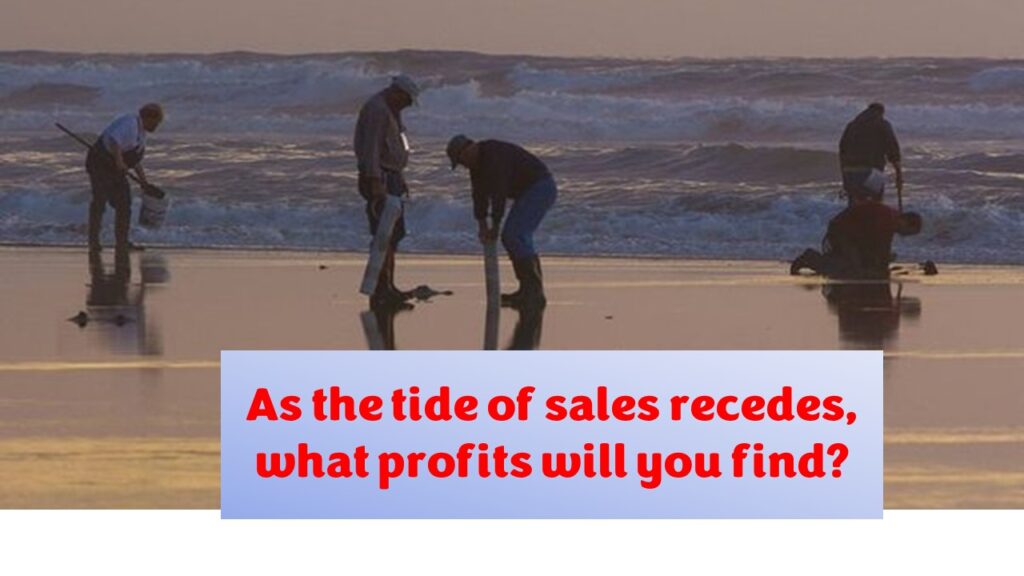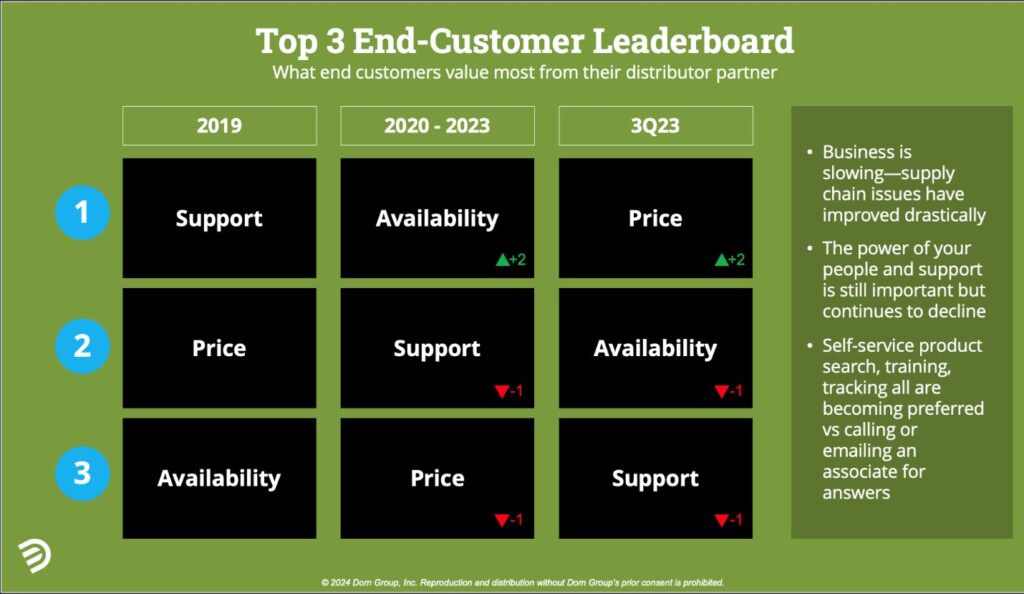As Sales Growth Recedes, The Role of Pricing
 Feedback from distributors at the NAED Eastern and the NAED Western forbode a challenging 2024. The vast majority are expecting “flat” or nominal organic growth. Trends I observed from those expecting “more” are one’s that are in the Southeast or Southwest, those who are benefiting from what I call “unicorn” projects (the large projects) which mean that there are winners and losers, and those that are targeting selected vertical markets within their territory. Pricing as a growth strategy wasn’t discussed.
Feedback from distributors at the NAED Eastern and the NAED Western forbode a challenging 2024. The vast majority are expecting “flat” or nominal organic growth. Trends I observed from those expecting “more” are one’s that are in the Southeast or Southwest, those who are benefiting from what I call “unicorn” projects (the large projects) which mean that there are winners and losers, and those that are targeting selected vertical markets within their territory. Pricing as a growth strategy wasn’t discussed.
And yes, there are ones that are planning on growth driven by acquisition, new branches, new salespeople and similar, but this requires investment.
Back to the organic growth issue. Stimulating this, frequently, requires thinking about pricing strategically. This can be at a customer level, within a targeted customer group, for selected products / product categories or a couple of more ways. Managing your price files, your pricing strategy, and strategically using SPAs (and remarketing to the SPAs you have) are all key to profitable success. Consider … in 2021 distributor net profit, according to the NAED PAR report, was 6.6%. In 2022 it was 6%. What will be reported for 2023 when sales rose less? For 2024? When the tide goes out, does the profit have to go with it?
Recently I was talking with John Gunderson who helps distributors with pricing. John has significant experience in the electrical industry and shared his thoughts:
It’s time to give your outside sales teams more pricing support and guidance in 2024
The supply chain issues of the past few years made it a unique time to be an electrical distributor and manufacturer. It was a time where if you could get the product to the customer the price of the product was secondary. Please do not get me wrong, having a fair price was still important, but it was a time where Availability was king.
 The above chart shows that end customers that I have surveyed over the past nine years over 10 industries, have consistently valued 3 key factors in “why they buy.”
The above chart shows that end customers that I have surveyed over the past nine years over 10 industries, have consistently valued 3 key factors in “why they buy.”
In the electrical channel changing how much a customer buys is hard, selling them products not on their P.O. is hard, but the one sales variable you can control is price.
The sell price is easy to change and going lower does often result in more sales. You may not make enough margin to be profitable, but you can grow top-line sales quickly with a price lever pull.
And the challenge for many distributors is balancing growth and profitability, especially when many salespeople are compensated with a percent of gross margin, so any margin dollar is beneficial to a salesperson … even if the net profitability is not beneficial to the company.
Now with demand softening and with the supply chain improving it is setting up for a year where getting a fair price is the top-rated buying factor. While it is not the only factor, for sure, in the decision but in 2024 getting your price right is important.
Here are 3 potential steps that I used as a pricing leader to get the right price to win more orders.
- Reset your floor pricing higher (minimum GM% at the SKU level) – with sales slowing it will cause more pressure, and your team will be more tempted to get down to the minimum floor levels, and your sellers know at what margin %’s the floor is at today. For example- If you choose to reset floors from a 6 to 9 GM% make sure you follow your current workflow for below floor order approval. This will allow you to continue to make good commercial decisions as having the account manager and manager talk about big orders you can take off the streets that are below floor is very healthy for your business. Communicate the new plan, write the rules, and allow your team to make any adjustments based on your approval workflow. In my experience this results in GM% gain while not curtailing top line sales.
- Spend time working on your Customer Specific Pricing (CSP)– Spend time doing a deep dive on all your CSP’s. Start date, end dates, last time changes, manual overrides from a CSP, etc. Where you have accounts that are on a CSP, but no Special Pricing Agreement (SPA) tied to SKUs that you have on a SPA with another customer do something about it. Look at those not on SPA SKUs that are on a SPA with other customers closely and go back to the manufacturer with a reasonable request on adding them to create a win-win for both parties.
- Take a deep dive into your price profiles- If you have a price profit system in place (e.g. you tie a customer to a blanket price profile with many SKUs based on their size and customer type) use that system to drive your business. You need to track who is tied to what price profile and if it is driving the behavior you want. For example – Do you have a $50,000 a year account that, if tied to a more aggressive profile, can grow to $100,000? Do you have a $50,000 a year account that is getting the same price as a $500,000 account and is just cherry picking you and giving the bulk of the business to a competitor? I am confident that the answer to both questions is yes.
From a manufacturer perspective I think it is often “out of sight, out of mind” on how a distributor is executing their sell price, and with both sides sharing only certain information, the collaboration is often limited. For a distributor it is crucial in 2024 for manufacturers to understand and get involved where they can, if they want to help a distributor grow “their” business jointly.
This is a complex process and not easy, as manufacturers have a fear of getting involved only to enter a “get me a lower price” discussion with a distributor. The opportunity for manufacturers in 2024 is that distributors are getting more sophisticated with their pricing approach and by growing SPAs, smartly, you can take share and never give it back.
These are just 3 actions you can take to maintain margin, but they won’t be effective on their own.
In 2024 the number one way to help your sales team is to provide them with a better pricing review and support process.
When I survey distributor salespeople about how often their managers review pricing with them, over 50%+ of respondents say they review pricing with their managers infrequently (less than one time a week).
Your sales team may be going low more often to get that sales funnel moving with orders. Winning profitably is going to take a combination of strategic pricing moves like the above 3 steps and management review and support of your account manager pricing tactics.
It’s a SKU-by-SKU street battle that you need to win. Getting your pricing team to find ways to help the sales team is the key to profitable sales growth.”
John Gunderson is a senior leader at Dorn Group with more than 20+ years’ experience leading category management, sales, marketing, pricing, analytics, and ebusiness with companies such as Crescent Electric Supply Company, HD Supply Power Solutions, Anixter/WESCO, and more. You can reach him at john.gunderson@dorngroup.com.
Thoughts
Pricing is an everyday function for distributors. It typically starts with purchasing. Some companies strategically set up price matrices and assign customers to them. Fewer manage this function on a regular basis. Salespeople have been known to override pricing (some consistently). There are times it could be valid, other times … And salespeople frequently desire “conflict avoidance” and are prone to acquiesce to customers rather than negotiate (when was the last time you negotiated a price at Home Depot?). Speaking of negotiating, when was the last time your salespeople were trained on customer negotiations and taken through an exercise on customer profitability?
The key to winning profitable and proactive price and sales management is education, information, communication and sometimes saying “no” to sales and customers. Recognizing your value proposition and being compensated for your value is important to healthy growth.
Sales can be achieved by strategically managing price … to win business and to grow profitable.























